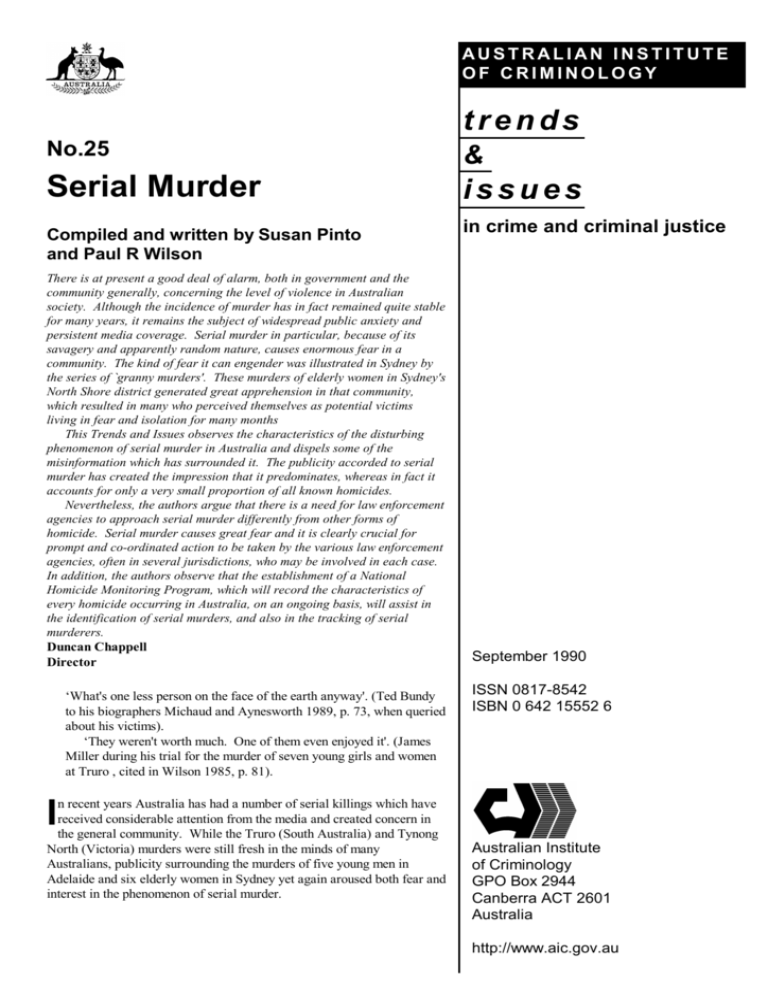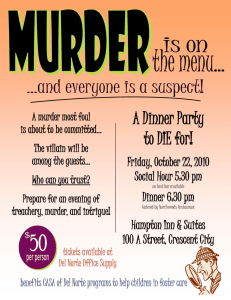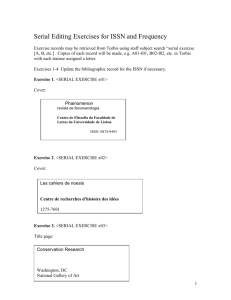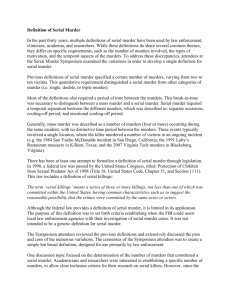paper (pdf 0.17 MB) - Australian Institute of Criminology
advertisement

AUSTRALIAN INSTITUTE OF CRIMINOLOGY trends No.25 & Serial Murder issues Compiled and written by Susan Pinto and Paul R Wilson There is at present a good deal of alarm, both in government and the community generally, concerning the level of violence in Australian society. Although the incidence of murder has in fact remained quite stable for many years, it remains the subject of widespread public anxiety and persistent media coverage. Serial murder in particular, because of its savagery and apparently random nature, causes enormous fear in a community. The kind of fear it can engender was illustrated in Sydney by the series of `granny murders'. These murders of elderly women in Sydney's North Shore district generated great apprehension in that community, which resulted in many who perceived themselves as potential victims living in fear and isolation for many months This Trends and Issues observes the characteristics of the disturbing phenomenon of serial murder in Australia and dispels some of the misinformation which has surrounded it. The publicity accorded to serial murder has created the impression that it predominates, whereas in fact it accounts for only a very small proportion of all known homicides. Nevertheless, the authors argue that there is a need for law enforcement agencies to approach serial murder differently from other forms of homicide. Serial murder causes great fear and it is clearly crucial for prompt and co-ordinated action to be taken by the various law enforcement agencies, often in several jurisdictions, who may be involved in each case. In addition, the authors observe that the establishment of a National Homicide Monitoring Program, which will record the characteristics of every homicide occurring in Australia, on an ongoing basis, will assist in the identification of serial murders, and also in the tracking of serial murderers. Duncan Chappell Director ‘What's one less person on the face of the earth anyway'. (Ted Bundy to his biographers Michaud and Aynesworth 1989, p. 73, when queried about his victims). ‘They weren't worth much. One of them even enjoyed it'. (James Miller during his trial for the murder of seven young girls and women at Truro , cited in Wilson 1985, p. 81). n recent years Australia has had a number of serial killings which have received considerable attention from the media and created concern in the general community. While the Truro (South Australia) and Tynong North (Victoria) murders were still fresh in the minds of many Australians, publicity surrounding the murders of five young men in Adelaide and six elderly women in Sydney yet again aroused both fear and interest in the phenomenon of serial murder. in crime and criminal justice September 1990 ISSN 0817-8542 ISBN 0 642 15552 6 I Australian Institute of Criminology GPO Box 2944 Canberra ACT 2601 Australia http://www.aic.gov.au Australian Institute of Criminology Although it is clear that Australia has not altogether escaped serial killers, it is equally obvious that the proportion of serial murders in the United States is much greater than in our society, even given their massive population. Names such as the `Boston Strangler', `Son of Sam', `Freeway Killer', `Stocking Strangler', `Green River Killer', `Lonely Hearts Killer', `New Orleans Axeman', John Wayne Gacy and Theodore `Ted' Bundy are well known as serial killers in the United States. Estimates of the number of serial killers currently at large in the United States vary considerably, ranging from the low 30s to over 100 (Holmes & De Burger 1986, p. 20). In this Trends and Issues the various facets of serial murder are noted, including definition, elements of the crime, occurrence in Australia, explanations for serial murder, the copy cat phenomenon and the special problems that serial murder pose for law enforcement agencies. Finally, there is a discussion of methods currently employed, or under consideration, which attempt to combat serial killings. Defining Serial Murder Although there is no universally accepted definition of serial murder, here the term will refer to a specific type of homicide involving the murder of two or more persons in separate incidents, with an interval of time between the homicides. The interval can be several hours, days, weeks, months or even years. Mass murder is another form of homicide which is commonly confused with serial murder. This type of murder characteristically involves the killing of several people, in the same general area, at roughly the same time, by a lone assailant. It is usually a one-time murderous act (Levin & Fox 1985). Excluded from the category of serial murders are professional killers, `contract' killers and people working from political motives. For example, killers who operate for the Mafia could not be labelled as serial murderers in the true sense of the word, despite having committed several homicides at different times. Elements of Serial Murder Holmes and De Burger (1988) have identified key elements applicable to serial murder. • The central element is repetitive homicide. • Serial murders usually occur between two people; a victim and a perpetrator. • The relationship between victim and perpetrator is usually that of stranger or slight acquaintance. Serial murder rarely occurs between people who are strongly affiliated. • Apparent and clear cut motives are typically lacking in many serial murders, due to the fact that `strangers' generally perpetrate this crime. There are, nevertheless, very real motives - even if they may appear non-rational - that originate within the individual. These motives govern and structure the serial killer's homicidal behaviour. In most cases the motives do not reflect passion, personal gain, or profit tendencies. • A common perception is that all serial murderers are lust murderers; that is, there is evidence or observations to indicate the murder was sexual in nature (Ressler et al. 1988, p. xiii). Although it is true that many serial murderers are lust killers, this is not always the case. It may be closer to the true situation to say that in most cases the perpetrator is a lust killer. Australian Serial Murders Tables 1 and 2 detail murders which have been identified as serial killings, based on our previous definition and description of the elements of serial murder. These tables do not represent a comprehensive listing of all occurrences of serial murder in 2 Australia. Although some Australian jurisdictions have undertaken occasional analyses of homicide trends and patterns (South Australia 1981; Wallace 1986; Bonney 1987; Law Reform Commission of Victoria 1988), there is no ongoing monitoring system operating in any state or territory. National baseline data and uniform national homicide statistics remain elusive, and information about the characteristics of homicide victims is unavailable (National Committee on Violence 1990, p. 218). The situation is further complicated by the number of missing persons in Australia. Swanton and Wilson (1989) suggest that approximately 250 persons are outstanding on state police missing persons files at any one time, exclusive of long-term missing persons and institutional absconders. Although it is impossible to assess accurately how many of these people have been victims of serial murder, police are reasonably certain that a proportion may have been. At this point, it is important to note that although the actual number of serial murders in Australia is presently unknown it appears that the number of murders committed by `strangers', a common element of serial murder, is relatively small. A study by the New South Wales Bureau of Crime Research and Statistics found that `strangerkillings', so often portrayed in the media, account for less than one in five killings in New South Wales (Wallace 1986, p. 3). According to the evidence provided by studies throughout the world in which the relationship between homicide offenders and their victims were examined, the homicide victim is typically an intimate of the offender, most commonly a family member or friend (Curtis 1974). The following discussion includes some specific cases of murder in Australia, which although not solved, appear to be the work of serial murderers. The Truro murders, possibly the most well-known of all Australian serial murders, are also discussed. Australian Institute of Criminology North-Shore `Granny' Murders The `granny' killings, so-called because all but one of the victims were over the age of 80, involved the murders of six women in Sydney's north-shore district between 1 March 1989 and 19 March 1990. The victims were all attacked in the vicinity of their homes in broad daylight with some kind of blunt instrument. Two of the women were strangled with their own stockings. A 57-year-old man was charged with the murders in March 1990. It is alleged that the offender, after strangling the last of the murder victims, undressed, climbed into a bath and took an unknown quantity of prescription drugs. A two week committal trial is expected to begin in October 1990. Adelaide Murders Between 1979 and 1983 the bodies of five young men, between the ages of 14 and 25, were discovered in Adelaide. The victims all had similar types of wounds, several were washed and dressed and their bodies disposed of in similar ways. The television program `60 Minutes' in 1989, numerous newspapers and some police officers have suggested that there are links between the five murders and a group, dubbed the `Family', which has allegedly picked up and drugged numerous young men for up to 20 years. Despite all the speculation there is, however, no persuasive evidence that such a group exists. A man has been convicted of the murder of one of the five boys and is currently serving a life sentence with a record 36-year non-parole period. Truro Murders In the summer of 1976-77 the bodies of seven young women were discovered near Adelaide. A 40-yearold labourer, James Miller, stood trial for the killings. It was alleged that Miller, together with accomplice Christopher Worrell (subsequently killed in a car accident), picked up the seven victims and raped and murdered them. Miller was found guilty of six of the seven crimes. Forensic evidence suggested that all the victims had been strangled, either manually or by ligature, although there was a strong suspicion that the last of the victims had been placed alive in a makeshift grave (Wilson 1985, p. 80). Wanda Beach Murders The bodies of two 15-year-old girls were found on January 11 1965 at Wanda Beach, Sydney. The girls had been brutally bashed, stabbed and sexually violated. On January 29 1966 the body of a 57-year-old woman was found in Piccadilly Arcade in Wollongong. The victim had been strangled, viciously bashed, mutilated and possibly sexually assaulted. Four days after the Piccadilly Arcade murder the body of a 27-year-old woman, a known Kings Cross prostitute, was found near Lucas Heights, south of Sydney. Police suspect that there are links between the Wanda Beach murders and the other two murders. Indeed, there appears to be striking similarities between all three murders. In each case a body was dragged along the ground with no real attempts made to conceal the bodies. Sexual molestation after the slaying was involved in all cases, and the victims were murdered near or in Sydney. Explanations for Serial Murder Explanations provided for serial killings vary considerably and range from those which suggest that serial killers have an additional chromosome (the XYY theory) to those describing serial murder as a disease with characteristics as distinct as cancer or leprosy. These theories do not, however, have sufficient evidence to warrant much credence. This paper focuses on psychological, sociological and cultural explanations. Sociological explanations generally stress `social disadvantage', including unemployment, financial hardship, ill health, economic inequality, lack of housing and discrimination. Psychological explanations tend to 3 explain serial murder as a result of individual propensity to commit murder, including the inability to conceptualise right from wrong, willingness to inflict injury on others, inability to perceive future consequences of actions and degree of impulse management. Cultural explanations for serial murder focus on the extent to which cultural factors enhance the probability of the occurrence of serial murder. These include the influence of mass media, feelings of alienation and estrangement on the part of marginal members of society, normalisation of interpersonal violence and values and prestige a society attaches to violent behaviour. There are considerable difficulties in attributing these explanations to the phenomenon of serial murder. Serial murderers represent a diverse range of personality types, with varying backgrounds, motives and reactions to crimes. For example, John Wayne Gacy (suspected of killing 33 boys and young men) and Ted Bundy (suspected of killing 36 women) were generally considered to be respectable citizens from middle class backgrounds. These men generally selected their victims carefully before murdering them and mutilating their bodies. By contrast, David `Son of Sam' Berkowitz killed at random, claiming to be subject to the whims of his neighbour's dog. Berkowitz was illegitimate and had an emotionally and economically deprived upbringing. Consequently, serial killers cannot be neatly categorised into a particular behavioural type. While researchers and therapists must endeavour to recognise the nature of the crime and document the social, psychological and situational aspects of victim-offender interaction, this documentation should occur within a framework which recognises that serial killing is not committed by specific psychological or sociological types. Additionally, although it is important to observe the background of homicidal violence, it is misleading to assert that serial murder is `caused' Australian Institute of Criminology Table1 : Solved Serial Murders in Australia* Year/Location Number and Sex of Victim(s) 1900-06 Suspected of killing 37 Perth babies 1930-35 4 Females 6-16 yrs 1942 3 Females Melbourne 31-43 yrs 1961 ** 1 Female 16 yrs‡ Sydney 1 Female 15 yrs‡ 1972 in prison, Sydney attempted murder of 1 female 1959-65 2 Females‡ Perth 4 Males 1961-62 4 Males 24-28 Aug. 1973 Sydney 1976-77 Truro (SA) 3 Males 25-50 yrs 6 Females‡ 15-26 yrs 1979-80 Sydney 2 Females 16 mths & 2 yrs 1 Male 7 yrs 2 Males 11 & 12 yrs 1 Male 8 yrs 4 Females‡ 15-31 yrs 4 Males 26-70 yrs 1 Female 25 yrs 1984 NSW 1986 NSW Oct.- Nov. 1986 Perth 09 Jul. - 14 Jul 1987 NT and WA Offenders Alice Mitchell Sex/Age of Offender Female Arnold Soderman Male 30 yrs Edward Leonski Male 25 yrs Male 26 yrs Strangulation Stabbing Strangulation Stabbing Artist Male 32 yrs Male 36 yrs Shooting Strangulation Stabbing Sexual Mutilation Truck driver Male 25 yrs Male 36 yrs Male Shooting Unknown Strangulation Labourer Unknown Female 18 yrs Suffocation Strangulation Baby Sitter Male 42 yrs Drowning Farmer Leonard Lawson Eric Cooke Alan Brennan alias William McDonald & Allan Ginsberg Archibald McCafferty James Miller Christopher Worrell (accomplice) Patricia Moore Michael Laurence Method of Killing Employment Starvation Negligence Strangulation Baby Nurse Labourer/Road Constuction worker American G.I Private Unknown Suffocation Drowning David Birnie Catherine Birnie (accomplice) Josef Schwab Table 2: Unresolved Serial Murders in Australia* Year / Location Number and Sex of Victim(s) Jan. 1965 4 Females‡ Jan. 1966 (NSW)## 1979-83 5 Males‡ Adelaide 14-25 years 1980-83 2 Females‡ Tynong North 14-18 yrs (Vic) 1 Female 34 yrs‡ 1 Female 75 yrs March 19841 Female 60 yrs March 1990 5 Females North Shore of Sydney 81-92 yrs (NSW) Nov. 1962 Female 5 yrs June 1990 Female 9 yrs Notes to both Tables: Male 36 yrs Female 35 yrs Male 26 yrs Method of Killing Bashed Stabbed Sexual Mutilation Unknown Bashed Strangulation Strangulation Strangulation * These Tables do not necessarily include all occurrences of serial murder in Australia. Table 1 respresents solved serial murders in Australia, which generally include those for which a conviction has been recorded. Table 2 represents unresolved serial murders in Australia, including cases where a suspect has not yet been apprehended and cases where a conviction has not yet been recorded. ** These cases occurred on consecutive days. † Lawson was also convicted in 1952 of the rape of two teenage girls. He was sentenced to life imprisonment and released on Parole in 1961. ‡ In these cases the victims were also raped. # German tourist holidaying in Australia. ## Police suspect that these murders were the work of a serial killer. Mutilation Strangulation Stabbing Shooting Labourer Housewife Public Servant# directly by an individual factor or even a specific pattern of factors. While it is undoubtedly true that certain sociological and psychological factors are important in the creation of a violent and aggressive personality, these factors do not sufficiently explain the specific motives that impel the serial killer. Similarly, it is possible that aspects of the general culture violence exemplified in mass media entertainment, justification of violence as a `normal' mode of dealing with problems, and anonymity and depersonalisation in contemporary society - enhance the risk of serial murder in our society. It is, however, difficult to determine the specific mechanisms by which a culture of violence may be translated into the heinous crimes characteristic of serial murder. Is the serial killer mentally ill? In attempting to understand fully the phenomenon of murder, the mental stability of the offender has assumed 4 Australian Institute of Criminology considerable importance. Arguments over whether homicide offenders are `bad' or `mad', or both, continue today and are likely to continue for some time in the future (Wallace 1986, p. 55). The relationship of mental disorder to violence, and homicide in particular, is however, extremely difficult to determine. Accordingly, the literature on homicide reveals that homicide can be `caused' by almost any kind of psychiatric illness, including feeblemindedness, retardation, senility, paranoia, epilepsy, manic and depressive psychosis and `psychopathic' personalities (Wolfgang & Ferracuti 1967). The significant blurring around issues of mental illness and insanity is reflected in the variation in the assessments of mental states of murderers in various countries. For example, in England the association of madness with murder is much more common than in the United States (Lunde 1975). Between 1957 and 1968, 8 per cent of those tried for murder in England and Wales were found legally insane (Gibson & Klein 1969); however in the United States only 2-3% were found insane (Lunde 1975). Although it is true that the differences could be partially due to the different structure of homicide in the two countries (for example the relatively high proportion of felony murders in the United States), it is clear that other considerations must be taken into account (Wallace 1986, p. 56). According to Wolfgang and Ferracuti: The percentage of `mentally ill criminals' vary, not so much in accordance with demonstrated variations of the phenomenon, but in the nosographers and medico-legal norms employed, and in the orientation of the examining psychiatrist (Wolfgang & Ferracuti 1967, p. 209, cited in Wallace 1986, p. 57). Studies and investigations of serial and sadistic murderers have argued that most such killers are neither insane within the McNaughten rules (legal guidelines which define sanity), nor psychotic (Brittain 1970, Bartholomew et al. 1975, Holmes & De Burger 1988, Norris 1988, Wilson 1988). Although it is difficult to believe that persons who commit horrific and devastatingly cruel crimes are `normal' people, scientific and psychiatric evidence does not lead inevitably to the conclusion that the majority of these killers are mentally ill. It is clear, nevertheless, that those who kill repeatedly and without remorse are suffering from an aberrant and socially defective mind set (Holmes & De Burger 1988), although this is not in itself evidence of psychiatric illness. Copycat Phenomenon Extensive media reporting given to serial murder may have the unintended consequence of encouraging others to commit similar crimes. For example, in Chicago in 1982 seven people died after ingesting Tylenol capsules, a commonly used pain killer, which had been contaminated with cyanide. Following nationwide television and newspaper coverage, poisons of various forms were discovered in pies, lollies, mixed nuts, mouthwash and a variety of over the counter drugs (Levin & Fox 1985, p. 23). Studies have demonstrated the existence of copycat effects, known formally as contagion phenomena or imitative behaviour. Research conducted by Bollen and Phillips (1982), Mazur (1982) and Phillips (1986) suggests that there could be a link between the degree of publicity attached to a homicide, suicide or terrorist incident and subsequent conduct of a similar nature. The influence of violent, sadistic pornographic material may also be relevant here. In the United States several serial killers were found to have an obsessive interest in sexually violent pornographic literature and videos (Wilson 1988, p. 273). In Australia it was revealed during the trial of the Truro murderers that both accused men kept a large, locked trunk filled with pornographic magazines, most of which emphasised sadism and bondage. Wilson (1985 p. 83) has argued that the glorification of violence in sex, as reflected by much 5 pornography, mirrors the emphasis that society places on the interlocking of the sexual and the aggressive. Although the strong link established between sadistic pornography and sadistic crimes cannot be ignored, again it is necessary to exercise caution when attributing these factors directly to the causation of serial murder. Control Mechanisms Serial murder raises serious challenges for law enforcement agencies. Experience in the United States, Britain, Canada and Australia demonstrates that serial killers are particularly difficult to apprehend and law enforcement often inept in coordinating searches for this type of killer. The most notorious example is provided by the investigation of the `Yorkshire Ripper' from 1975-81. By mid-1977 excellent detective work had focused the trail on Peter Sutcliffe's firm and Sutcliffe was interviewed; however, his file was then marked `no further action required'. The trail became lost and police put mistaken credence in a series of letters and tapes purporting to come from the killer. Sutcliffe was thus able to kill eight more times before being apprehended (Jenkins 1988, p. 11). Whereas motives for `normal' homicides are generally relatively easy to detect because of the victim-offender relationship previously discussed, in a crime such as serial killing there is no readily identifiable motive. The difficulty for the investigator is first identifying that the murder may be the work of a serial killer, as an isolated killing will probably be insufficient to alert the investigator to this possibility. Seldom is there enough evidence at one crime scene for investigators to build a case. The next crime may be in a different jurisdiction, seemingly unrelated to the first. The killer's mobility and random victim selection complicates the investigation (Brooks et al. 1987, p. 40). Reflecting the unusual difficulties this form of murder presents for law Australian Institute of Criminology enforcement agencies, some control mechanisms have been established. A discussion of these follows. Violent Criminal Apprehension Program (VICAP) In the United States an attempt to contend with serial killings is the national Violent Criminal Apprehension Program (VICAP). Based at the FBI Academy in Quantico Virginia, this program provides a computerised clearinghouse for information on unsolved murders, violent or deviant sexual assaults and kidnapping's or disappearances. It is the objective of VICAP to provide law enforcement agencies reporting similar patterns of violent crimes with the necessary information to initiate a coordinated multiagency investigation so they may identify and apprehend offenders as expeditiously as possible (Brooks et al. 1987, p. 41). The VICAP computer system also produces selected reports which monitor case activity geographically, with the hope that it will eventually trace the movements of violent serial offenders across the United States (Ressler et al. 1988, p. 113). National Homicide Monitoring Program The Australian Institute of Criminology is currently in the process of establishing a national Homicide Monitoring Program. The major functions of the Program will be the systematic collection of information on cases of homicide coming to the attention of Australian police agencies, and the analysis of these data. In time, it is possible that the Program may be able to assist police in identifying linkage patterns in homicides throughout Australia. National data of this type have hitherto been unavailable. The Program hopes to publish annual reports on patterns and trends in homicide, which may aid police in the identification of serial murders. DNA DNA (deoxyribonucleic acid) matching (also known as DNA profiling and fingerprinting) is a method of identifying biological samples by analysing the genetic material or DNA contained in the cells. Using this technique, blood, semen or other human tissue found at 6 the scene of a crime can be matched to a sample taken from a suspect. Similarly, blood or other tissue found on a suspect can be matched to that of a victim (Kearney 1989, p. 2). Alternatively, DNA matching has the power to exclude a suspect if a nonmatch is evident. It is clear that DNA matching has the potential to benefit police in their investigations of serial murders. Police are able to match DNA found at different crime scenes to establish whether the same person is responsible for the crimes, thereby establishing the likelihood that they are dealing with a serial killer. While DNA is possibly the most important development in forensic evidence for law enforcement this century, it is important that it be kept in perspective. Although scientists assert that DNA patterns are `unique', they also acknowledge that one individual's DNA patterns may have similarities with another's. In some cases it is possible that similarities may be striking, while in other cases the DNA structure may in fact be identical (Scutt 1990, p. 9). DNA is an extension of a technology which allows more precise results. Law cases where the identity of the person Australian Institute of Criminology is the only issue are few. In sexual assault cases, the question of consent is paramount; in assault, the question of provocation and so on (Selinger 1989, p. 6). In addition, the scientific community has not yet agreed on standards that ensure total reliability of the evidence (Lander 1989, p. 501). Criminal Profiling Criminal profiling can be defined as a technique for identifying the major personality and behavioural characteristics of an offender, based upon an analysis of the crime committed and the information obtained from the scene of a crime. Profiling does not provide the specific identity of the offender. Rather, it indicates the kind of person likely to have committed a crime by focusing on certain behavioural and personality characteristics (Douglas et al. 1988, p. 402). The criminal profile generating process is described as having five main stages, with a sixth stage, or goal, being the apprehension of a suspect (see figure 1). Criminal profiling has been described as a collection of leads (Rossi 1982), as an educated attempt to provide specific information about a certain type of suspect (Geberth 1981) and as a biographical sketch of behavioural patterns, trends and tendencies (Vorpagel 1982). Detractors of psychological profiling dismiss it as very hit and miss. Specific criticisms are that the information from the profiler is: little better than information one could get from the neighbourhood bartender ... profiles are too vague and ambiguous or else they are simple common sense (Holmes & De Burger 1988, p. 85). Australian critics claim that a danger exists if police seize on a stereotyped view of the offender's profile and then encourage the community to adopt the same view through media reports (Canberra Times, 20 April 1990). According to Douglas (1986, p. 403) criminal profiling has been found to be of particular usefulness in crimes such as serial homicides which, because of their apparently random and motiveless nature, are given high publicity. Consequently, the public demands that law enforcement agencies act quickly to apprehend the offender. The challenge posed to law enforcement agencies by serial murder leads inevitably to the conclusion that complete cooperation between and within agencies in all jurisdictions is essential. Additionally, it is clear that sophisticated investigative techniques are required to confront the special problems presented by this form of murder. Although the national Homicide Monitoring Program may assist police agencies in Australia to identify related murders, it is unlikely to assist in apprehension. In this context, it is possible that criminal profiling may be of some benefit. Police agencies should explore the benefits of implementing such a system in Australian jurisdictions. The debate over the reintroduction of the death penalty for horrific and violent crimes often emerges after such crimes have taken place, but the deterrent effect of the death penalty is highly questionable. Potas and Walker (1987) have argued that the death penalty may create a brutalising effect, actually inspiring acts of violence, thereby diminishing rather than increasing the deterrent effect of capital punishment. Instead of focusing on penalties for such crimes, it is more appropriate to focus on strategies that will assist law enforcement agencies in identifying and apprehending serial murderers. Effective identification and apprehension of serial murderers in Australia is heavily reliant on the response of Australian police agencies to new technologies and advances in investigative analyses. Conclusion References Although serial murder currently represents only a small proportion of all homicides in Australia, the question of whether this situation may change in the future should be raised. In the United States experts have predicted that there is a very real possibility that serial murders will increase as the gulf between socioeconomic groups becomes more apparent and the marginalisation of some sections of society increases. Whether the same situation will occur in Australia, and indeed whether an effect of this will be an increase in the incidence of serial killers, is impossible to predict. In the meantime it is important that simplistic solutions to serial murder are not taken up. Serial murderers generally favour immediate gratification, regardless of the consequences. In the words of Douglas Clark, a man condemned to death for the sadistic murder of six adolescent girls: It doesn't bother me in the least ... there are a hell of a lot worse things that can happen than to die in the gas chamber (Los Angeles Herald Examiner, 16 February 1983). Bartholomew, A., Milte, K. & Galbally, F. 1975, ‘Sexual Murders, Psychopathology and Psychiatric Jurisprudential Considerations', Australian and New Zealand Journal of Criminology, vol. 8, June, pp. 143-53. Bollen, K. & Phillips, D. 1982, `A National Study of the Effects of Television News Stories', American Sociological Review, vol. 47, pp. 80209. Bonney, R. 1987, Homicide II, New South Wales Bureau of Crime Statistics and Research, Sydney. Brittain, R.P. 1970, `The Sadistic Murderer', Medical Science Law, no. 10, pp. 192-9. Brooks, P., Devine, M., Green, T., Hart, B. & Moor, Merlyn 1987, `Serial Murder: A Criminal Justice Response', Police Chief, vol. 54, no. 6, June, pp. 40-5. Curtis, L.A. 1974, Criminal Violence, Lexington Books, Massachusetts. Douglas, J., Ressler, R., Burgess, A. & Hartman, C. 1986, `Criminal Profiling from Crime Scene Analysis', Behavioral Sciences and The Law, vol. 4, no. 4, pp. 01-21. Gerberth, Vernon 1981, `Psychological Profiling', Law and Order, vol. 29, no. 9, Sept., pp. 46-52. Gibson, E. & Klein S. 1969, Murder 1957 to 1968, A Home Office Statistical Division Report on Murder in England and Wales, Home Office Research Study no. 31, London. Holmes, Ronald M. & De Burger, James 1988, Serial Murder, Sage Publications, Beverly Hills, CA. Jenkins, Phillip 1988, `Serial Murder in England 1940-85', Journal of Criminal Justice, vol. 16, pp. 1-15. Kearney, James 1989, Bridging the Legal-Science Gulf, Paper presented to DNA and Criminal Justice Conference, Australian Institute of Criminology, 30-31 October, Canberra. 7 Australian Institute of Criminology Lander, Eric 1989, `DNA Fingerprinting on Trial', Nature, vol. 339, June, pp. 501-05. Law Reform Commission of Victoria 1988, Homicide, Discussion Paper no. 13, Law Reform Commission, Melbourne. Levin, Jack & Fox, James 1985, Mass Murder: America's Growing Menace, Plenum Press, New York. Lunde, D.T. 1975, Murder and Madness, The Portable Stanford, Stanford, CA. Mazur, Allan 1982, `Bomb Threats and the Mass Media: Evidence for a Theory of Suggestion', American Sociological Review, vol. 47, pp. 40711. Michaud, Stephen & Aynesworth, Hugh 1989, Ted Bundy: Conversations with a Killer, North American Library, New York. National Committee on Violence 1990, Violence: Directions for Australia, Australian Institute of Criminology, Canberra. Norris, Joel 1988, Serial Killers: The Growing Menace, Doubleday, New York. Phillips, D.P. 1986, `Natural Experiments on the Effects of Mass Media Violence on Fatal Aggression: Strengths and Weaknesses of a New Approach' in Advances in Experimental Social Psychology, ed. L. Berkowitz, Academic Press, Orlando, pp. 207-50. Potas, Ivan & Walker, John 1987, Capital Punishment, Trends and Issues in Crime and Criminal Justice, no. 3, Australian Institute of Criminology, Canberra. Ressler, R., Burgess, A. & Douglas, J. 1988, Sexual Homicide: Patterns and Motives, Lexington Books, Lexington, MA. Rossi, D. 1982, `Crime Scene Behavioural Analysis: Another Tool for the Law Enforcement Investigator', Police Chief, vol. 49, no. 1, pp. 1525. Scutt, Jocelynne 1990, `Beware of New Technologies', Legal Service Bulletin, vol. 15, no. 1, pp. 9-12. Selinger, Ben 1989, The Scientific Basis of DNA Technology, Paper presented to DNA and Criminal Justice Conference, Australian Institute of Criminology, 30-31 October, Canberra. Swanton, B & Wilson, P. 1989, Research Brief: Missing Persons, Trends and Issues in Crime and Criminal Justice, no. 17, Australian Institute of Criminology, Canberra. Vorpagel, R. 1982, `Painting Psychological Profiles: Charlatanism, Charisma or a New Science?', Police Chief, vol. 49, no. 1, Jan., pp. 156-9. Wallace, Allison 1986, Homicide: The Social Reality, New South Wales Bureau of Crime Statistics and Research, Attorney General's Department, Sydney. Wilson, Paul R. 1988, `Stranger Child-murder: Issues Relating to Causes and Controls', Forensic Science International, vol. 36, pp. 267-77. Wolfgang, Marvin E. & Ferracuti, Franco 1967, The Subculture of Violence, Tavistock Publications, London. Inquiries about the Trends and Issues series should be forwarded to: The Director Australian Institute of Criminology GPO Box 2944 Canberra ACT 2601 Australia 8








